
Features
Operations
Saluting the Martin Mars
There are tall tales and there are true tales, but rarely are there true tall tales.
May 7, 2014 By Paul Dixon
There are tall tales and there are true tales, but rarely are there true tall tales. And you haven’t seen one of the greatest tall tales in Canadian aviation until you’ve come out West – way out West, on Vancouver Island, deep in the land of tall timber to the home of the Martin Mars, the world’s largest water bomber.
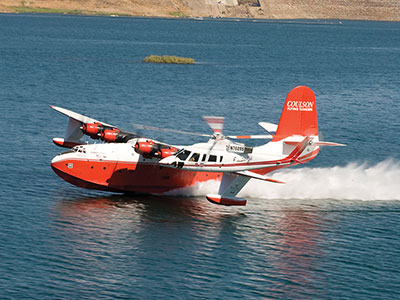 |
|
| The Hawaii Mars can scoop a full load (27,000 litres) in less than 30 seconds. Photo: Coulson Group
|
The origin of the Mars stretches back to the dawn of aviation and Glen L. Martin. An early business partner of the Wright Brothers, Martin taught William Boeing how to fly and sold him his first airplane. In the era following the Great War when airports were few and far between, the flying boat was king. Martin started building flying boats for the U.S. Navy and then was contracted by Pan American Airways to design and build a flying boat for mail and passenger service. The result was the China Clipper, which served an 8,200-mile route stretching from San Francisco to Manila, via Hawaii, Midway, Wake and Guam. The leg from San Francisco to Hawaii alone was 2,410 miles over the open ocean.
The Martin Mariner, a twin-engine flying boat built for the U.S. Navy, followed the China Clipper. While there were actually only three China Clippers ever built, the Mariner saw 1,285 serve through the Second World War and beyond. In August 1938, the U.S. Navy took the flying boat concept even further by ordering Martin to create the prototype of a “flying battleship” as the XPB2M-1. The original design bristled with machine guns and was to carry 10,000 pounds of bombs, more than twice the payload of the B-17.
Martin chose the name “Mars” for the XPB2M-1, but development was slow as other projects took precedence. The emerging dominance of the aircraft carrier ended the need for a flying dreadnought, but with the toll that U-boats were taking on Allied shipping, the navy decided to turn the battleship into a long-range “sky freighter” capable of delivering critical war supplies across vast distances. By the time the first prototype was evaluated in 1943, fortune was beginning to favour the Allies. The production order was cut to 20 aircraft from what was to have been hundreds.
When the war ended, the original order of 20 aircraft was terminated, with the five that had been completed entering service. The navy looked upon the aircraft as much as ships as aircraft, hence the individual names – Hawaii, Caroline, Philippines, Marshalls and Marianas – that reflected the Pacific routes the aircraft had been designed to serve.
The five aircraft operated from San Francisco Bay, carrying cargo and passengers to Pearl Harbour and beyond across the Pacific. From 1946 through 1956, the Mars, with a wingspan of 200 feet and a takeoff weight of 165,000 pounds, carried more than 250,000 passengers and thousands of tons of cargo. One flight from Alameda to San Diego saw 301 marines transported, along with their personal gear, and another flight saw 68,000 pounds of cargo delivered. During the Korean War, Mars aircraft were employed as flying hospitals to repatriate injured servicemen from hospitals in Japan.
The Marshall Mars was destroyed in 1950 when an engine fire during a maintenance flight forced an emergency landing at sea within sight of Pearl Harbour. While the crew was able to evacuate, the flying boat was consumed by the fire and sank. The four remaining Mars continued in service until the summer of 1956 by which time they had each accumulated between 18,000 and 20,000 hours each. The increasing efficiency of land-based aircraft made them redundant and the four went on the beach at Naval Air Station Alameda, awaiting their fate.
Resourceful thinking
In 1959, the navy declared the four as surplus and announced they would be auctioned off as scrap. This announcement caught the attention of Dan McIvor, then chief pilot for McMillan Bloedel, one of the dominant companies in British Columbia’s thriving forestry industry. It had been a particularly bad year in 1958 for forest fires in B.C. Aircraft had been used in a variety of water-bombing experiments, and while the concept had promise, the results were disappointing. In the evergreen forests of Vancouver Island where the Douglas Fir was king, trees routinely topped out at more than 200 feet, creating a thick, lush canopy. The small loads of water that existing aircraft delivered were not capable of breaking through that canopy to reach fires burning on the forest floor. McIvor was convinced that big trees called for big aircraft and the Martin Mars were those aircraft. He convinced the initially skeptical management of MacMillan Bloedel to buy all four aircraft and convert them to water bombers. The genius of McIvor was that he realized it would take more than simply having the aircraft to make this work. He tracked down every spare engine and part that he could find, paying pennies on the pound for the critical pieces that it would take to keep the aircraft flying for the next half century and more.
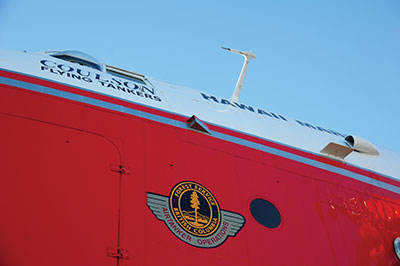 |
|
| You have to look up – way up – to get a sense of the sheer size of Hawaii Mars. In a word, massive. Photos: Paul Dixon
|
After three years on the beach, it took considerable time and effort to get the four planes back into a flyable state, but once they were airworthy again, they were flown up the coast to the Patricia Bay Airport (YYJ) outside Victoria where the conversion to the role of water bombers would be undertaken by Fairey Aviation. Fairey was already modifying Avenger torpedo bombers to commercial roles such as aerial spraying.
The first two Mars were stripped of everything not related to their new roles as water bombers. Then they were fitted with tanks fabricated from plywood and fiberglass that would hold 7,200 U.S. gallons. The tanks would be filled by two pickup probes that would be lowered into the water as the aircraft skimmed along the surface. No larger than a shoebox, the volume of water collected by the two probes would fill the tanks in under 30 seconds as the aircraft skimmed along at 70 knots.
John Gordon was an articling CA, working at Fairey that year. He recalls a sense of excitement throughout the organization as the project moved forward. In a stroke of luck, Gordon’s parents had recently bought acreage on the shore of Sproat Lake located in central Vancouver Island outside Port Alberni that would see Gordon’s parents become the next-door neighbours to the home base of the Martin Mars. He spent that summer – and many more – watching the giants practising their pickups and drops over the lake.
Putting theory into practice
Marianas was the first of the four to enter service under the banner of Forest Industries Flying Tankers (FIFT) in 1960. MacMillan Bloedel had convinced B.C. Forest Products, Pacific Logging, Tahsis Company and Western Forest Products, to join them in a joint venture with the aircraft that effectively created a private aerial firefighting enterprise to protect the interests of the partnership. The program suffered a setback in June 1961 when Marianas crashed during firefighting operations north of Nanaimo on the east coast of Vancouver Island, killing all four crew members. A year later, Caroline was damaged beyond repair by Typhoon Freda when parked onshore. Hawaii and Philippine entered service in 1963 and they served faithfully as a one-two punch against wildfires for more than 40 years.
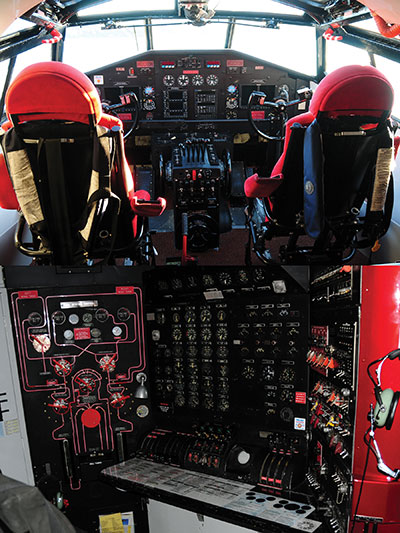 |
|
| The Hawaii Mars with its glass cockpit on top and the flight engineers work station below. Photos: Paul Dixon
|
Dan McIvor preached the concept of “gallons per hour” in terms of aerial firefighting, putting as much water as possible on the fire as soon as possible and not letting up. For years, forestry was the economic engine of Vancouver Island and every acre lost to wildfire had a direct impact on the bottom line of the forestry companies, which in turn had implications on the total economy of the region. The Mars quickly proved to be the right tool for the job. Vancouver Island is almost 300 miles long, but no more than 50 miles across at its widest. With a number of large lakes in the interior of the island, there are not many spots that are more than 15 minutes between a water source and the delivery point for the Mars.
Working together, the two aircraft would work opposite sides of a circular route that would see them working a fire in a constant one-two barrage. Early in the day, with a full load of fuel, the load would be 4,000 gallons of water, but as the fuel went down, the amount of water would increase until by the end of the day, the load would be the full 7,200 U.S. gallons. In the first year of operation in 1963, 495,000 gallons were dropped on nine operational fires and in 1965, the two aircraft dropped more than one million gallons.
Hugh Fraser flew the Mars for 32 years. His introduction to the planes came when he flew a charter customer into the firebase at Sproat Lake. “I landed, taxied in and then they directed me up the ramp” where he found himself staring into the belly of one of the Mars from the cockpit of his Mallard. “I just could not believe the size of this thing, it was humungous sitting up there,” he said. “My Mallard would have fit between the hull and float under one wing. I was all eyeballs, but unfortunately I didn’t have time to stick around.”
It wasn’t all that much later that Hugh was back at the firebase, but now as the newest pilot in the company. So, how does he remember his first hands on experience with the aircraft? “It scared the #**&#%$# out of me,” he says, and left him wondering what he had got himself into. That feeling quickly went away and Fraser went on to become the longest serving Mars pilot. Back in the day, the two Mars were teamed with a Grumman Goose as their birddog with pilots sharing the duties. “Each pilot was flying both airplanes, the Mars and the Goose,” says Fraser. “We worked six days on and two off, so four of those days would be on the Mars and two would be on the Goose. When you were following the Goose into some smoke-filled valley, you knew you had another Mars pilot leading you in, which gives you an awful lot of confidence.”
After 32 years, has Hugh Fraser recovered from his first impression of the Mars? “I can’t say enough about the airplane,” he noted. “They are the most stable platform you can possibly imagine and once you’re trained on how to fly them, it’s the easiest thing in the world to fly.”
The Mars was so successful in its environment because they were all company aircraft, the pilots and support staff were company employees and the fires they were fighting were on company property. It was much like a private air force. During some years, the aircraft flew a lot and in others, they didn’t fly much at all. The pilots were on salary and whether they flew a little or a lot, it didn’t affect their income. In their early years, the aircraft rarely ventured off their home turf, but when they did, the big red and white birds made a huge impression. As fires started growing larger and became more damaging, the Mars was dispatched around the province to work on the biggest fires. During the summer of 2003, B.C.’s worst fire season to date, the two Mars logged 272 flying hours for the province.
Adapting to change
B.C’s forest industry has evolved drastically since 1960. Much of the first growth old timber is gone as are many of the companies that pioneered the industry. Companies have merged, some simply have disappeared. MacMillan Bloedel, which itself was the result of an earlier series of corporate mergers and acquisitions, ceased to exist in 1999 when it was acquired by the American giant Weyerhaeuser. New legislation, government policies and changes in forestry practices have had an impact on the status quo and the owners of the Mars ultimately could no longer justify its expense. The aircraft were put up for sale in 2006 and bought in the spring of 2007 by the Coulson Group, which has deep roots in the Alberni Valley.
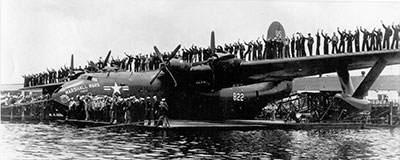 |
|
| How big is big? Some 135 U.S. Navy personnel on the wing of the Marshall Mars. Photo: U.S. Navy
|
Wayne Coulson took the Mars’ aerial firefighting show on the road, aggressively marketing Coulson Flying Tankers in the state of California. In August 2007, Hawaii was engaged in fighting fires in the Lake Elsinore region. In 2008, Hawaii returned to California to fight fires around Lake Shasta. With the fires adjacent to the lake, Dan McIvor’s “gallons per hour” methodology was the rule of the day. Coulson recalls attending the daily 8 a.m. briefing sessions on that fire. “They’d go around the table asking how much they had done the day before,” he says. “We thought we were doing well when we were knocking off 140,000 gallons in six hours. The air tanker base at Redding was putting out 70,000 gallons of retardant and the eight (Air National Guard C-130) MAFFs were doing 50,000 a day combined. They couldn’t believe our numbers and we did it day after day.”
In 2009, Coulson installed a Garmin EFIS Glass Cockpit system in Hawaii, consisting of two Primary Flight Displays (PFD) and two Multi-Function Displays (MFD). The PFD screens display aircraft details and Synthetic Vision while the MFD screens display GPS, Terrain Avoidance, Traffic Collision Avoidance (TCAS), and XM Weather data. Coulson’s birddog for the Mars is the S-76 Firewatch helicopter, equipped with a Honeywell EFIS Glass Cockpit, certified for single pilot IFR operations. The helicopter has a full Air Tactical Group Supervisor (ATGS) radio package and plugs for agency radios. The rear cabin has seating for six, a 26-inch HD TV and a full electronics and data suite. Coupled with the HD video and IR cameras mounted under the nose of the helicopter, Firewatch is an airborne command and control centre.
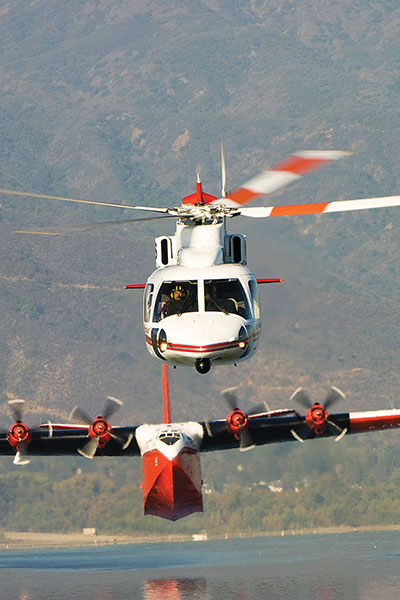 |
|
| The Hawaii Mars is often accompanied by the high tech S-76 Firewatch. Photo: Coulson Group
|
In 2010, the B.C. Ministry of Science and Technology recognized Coulson’s foresight in aerial firefighting by awarding its annual Innovation Award for the work on the Mars and Firewatch, “which transformed an aircraft destined to be a museum piece into the most advanced forest fire-fighting and urban interface/structure protection technology in the world.” In 2011, the technology was put to the test when the Hawaii went to Mexico as the feature of a Discovery Channel’s Mighty Planes episode. Flying from a lake that straddled the U.S./Mexico, Hawaii spent three weeks attacking out of control wildfires in northern Mexico, with Mexican officials riding in Firewatch and directing operations in real time.
Last year, however, the province of B.C. announced that it would no longer consider the Mars as a firefighting resource, replacing it with four small single seat air tankers (SEAT), with no further explanation offered. When the news broke, the local community was outraged. John Douglas, mayor of Port Alberni, describes the Mars as an integral part of the regional history. “It’s something that everybody here is really proud of and we feel that these aircraft are a part of us,” he says. Douglas received a unanimous endorsement from the Union of B.C. Municipalities to lobby both the provincial and federal governments to find a way to reinstate the Mars, but he has found little support for the aircraft at either level.
Wayne Coulson has gone back over the logbooks and reckons that over their service, the two Mars have done approximately 4,000 drops each at an average of 5,000 gallons. That’s an unbelievable 40 million gallons. In one single day, in the distant past, Philippine dropped 235,000 gallons. “That,” says Coulson, “is amazing from one aircraft and you will never see that again.”
Glenn Martin’s company lives on today as the second name in the Lockheed Martin conglomerate. McIvor has received the Order of Canada for his contribution to aerial firefighting and is enshrined in the Canadian Aviation Hall of Fame. While Coulson sadly acknowledges this is likely the end of the road for the Mars, his company continues to break ground in aerial firefighting, with its C-130Q Next Generation air tanker working in the U.S. with the Firewatch S-76.